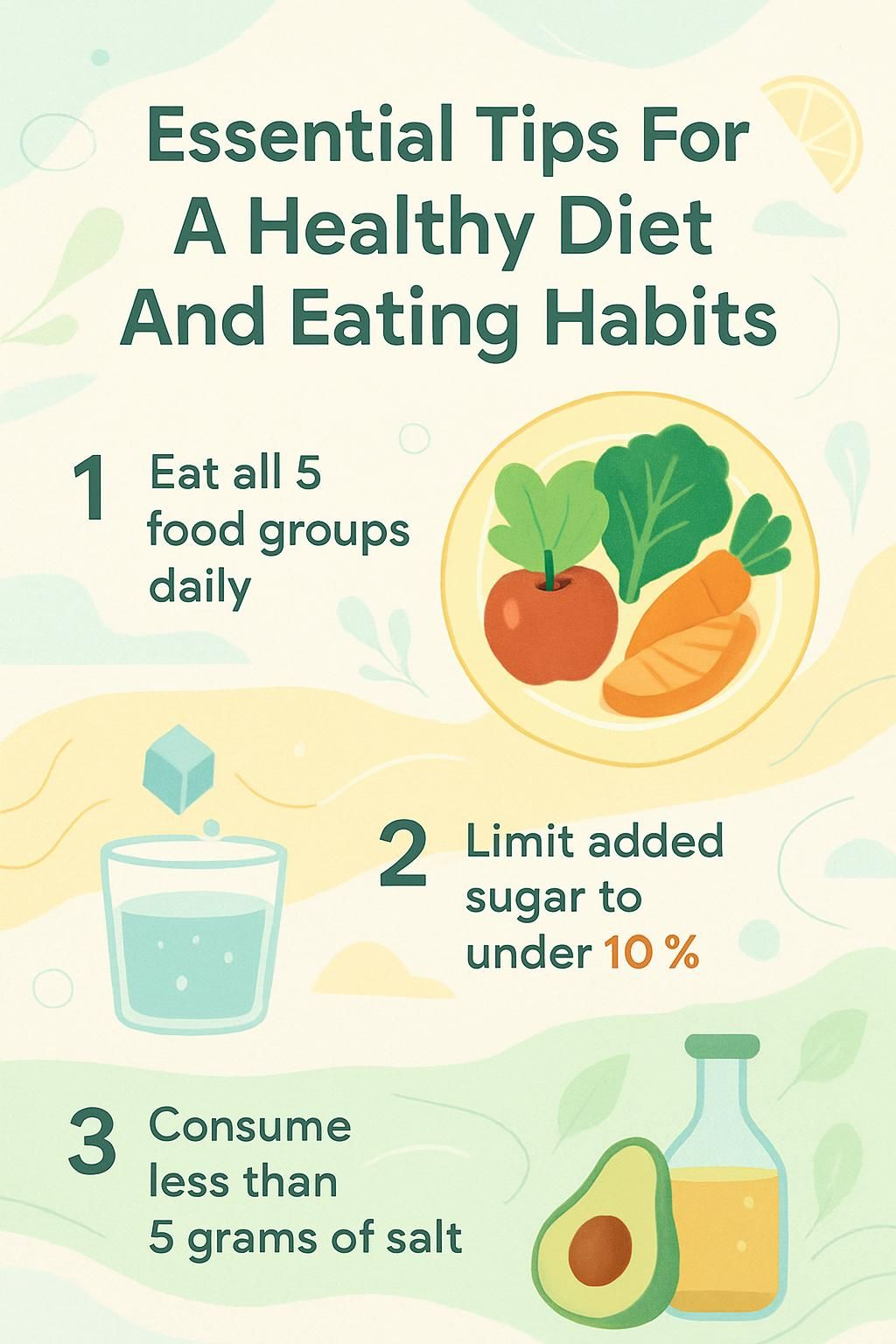Essential Tips For A Healthy Diet And Eating Habits
Our Nutrition Assistant AI Suite will transform your body. You will lose fat, get toned, and build muscle. Gain confidence and optimal health.
Many people want a healthy diet but feel unsure about what to eat each day. I have felt that same confusion. Learning that a balanced diet lowers the risk of heart disease and helps with weight control pushed me to find reliable answers.
After reading research and testing ideas in my own kitchen, I found simple ways to practice healthy eating. In this article, you will see practical tips for healthy habits, why each food group matters, and how small changes to daily meals add up. These steps can fit busy lives and tight budgets.
Key Takeaways
- Eating a balanced diet that includes all five food groups lowers the risk of heart disease and stroke, as shown in large studies from the Harvard T.H. Chan School of Public Health.
- Keeping added sugars under 10 percent of daily calories and salt under 5 grams per day helps prevent high blood pressure, obesity, and other chronic diseases, according to the World Health Organization.
- Replacing saturated fat with unsaturated fat from olive oil, nuts, or fish reduces cardiovascular risk, which aligns with WHO’s REPLACE strategy launched in 2018.
- The DASH and Mediterranean diets support lower blood pressure and fewer early deaths by focusing on fruits, vegetables, whole grains, low-fat dairy, and healthy fats.
- Mindful eating habits, such as avoiding skipped meals and reading labels, help steady energy, support weight management, and benefit mental health.

What is a Healthy Diet?

A healthy diet gives your body nutrients, energy, and dietary fiber from a range of foods. Balanced nutrition supports a healthy weight and lowers the risk of long-term disease.
What does a healthy diet mean?
A balanced diet means eating the right amounts from five main food groups. These include fruits, vegetables, whole grains, lean proteins such as fish or poultry, and healthy fats like olive oil or nuts.
Daily calorie needs vary. Many women need around 2,000 calories, while many men need up to 2,500 calories. The Healthy Eating Plate offers a simple way to build meals that support healthy growth and a healthy body weight.
Nutrition is not low-fat. It is not low-calorie. It is not being hungry and feeling deprived.
I try to fill half my plate with fruits and vegetables. Experts suggest at least five portions a day. I also limit highly processed foods that are loaded with saturated fat or added sugar. This approach reduces the risk of heart disease and type 2 diabetes.
Why is balanced nutrition important?
Balanced nutrition provides vitamins, minerals, and steady energy for daily life. Eating across all food groups, such as fruits, vegetables, whole grains like brown rice or oats, healthy fats from vegetable oils and nuts, and lean proteins from beans or fish, helps prevent malnutrition.
I choose minimally processed foods to lower my risk of diabetes, heart disease, stroke, and some cancers. Healthy habits start early. Breastfeeding supports healthy growth and is linked with lower childhood obesity. The American Heart Association encourages a wide variety of healthy foods because this pattern lowers blood pressure and cholesterol. It also supports a healthy weight.
Balanced meals keep my energy steady, which helps me stay active without feeling tired.
Key Components of a Healthy Diet
I focus on the building blocks of a healthy eating pattern. These simple rules guide my choices and make healthy eating feel easier day to day.
Why are fruits and vegetables essential?
Fruits and vegetables lower the risk of heart disease, high blood pressure, and stroke. Eating at least 400 grams a day, about five portions, reduces the chance of these diseases.
They are rich in fiber, vitamins, and minerals like potassium, which supports healthy digestion and immune function. A portion is about 80 grams for fresh or frozen. Dried fruit is 30 grams per portion. Juice counts as only one small glass, 150 milliliters, per day.
Many people fall short of these amounts even though these foods are filling and low in calories. I add berries to oatmeal and pile leafy greens into sandwiches. Small steps like these help me hit my daily goal.
“Eat at least five portions of fruit and vegetables every day to help you maintain a healthy body.”
How do whole grains benefit your health?
Whole grains, like whole wheat bread, brown rice, oats, and barley, deliver more fiber than refined grains like white bread or white rice. I base many meals on these higher fiber grains because they aid digestion and keep me full longer.
Guides like the Eatwell Guide highlight whole grains as a core part of a healthy eating pattern. Studies show people who eat more whole grains may cut their risk of heart disease and stroke by up to 30 percent compared with those who rely on refined grain foods. Fiber-rich choices like oatmeal or quinoa may also support weight control by slowing sugar absorption and curbing hunger.
Choosing whole grain cereals and breads can help with blood pressure control over time.
What are the best sources of lean proteins?
Fish, poultry, beans, and nuts offer protein without a lot of saturated fat or extra calories. I aim for fish twice a week. One serving often comes from oily fish like salmon or mackerel, which supports heart health.
Beans and nuts work well in salads or soups and bring protein and fiber to a meal. For dairy, I choose low-fat or fat-free options to reduce saturated fat while keeping calcium high. Lean meats like skinless chicken breast are solid choices, and I trim any visible fat before cooking.
My doctor suggested I limit processed meats such as bacon and salami due to sodium and links to weight gain. I swapped some red meat for lentils and noticed better cholesterol numbers.
Which fats are considered healthy?
After choosing lean proteins, I focus on healthy fats. Unsaturated fats support healthy cholesterol levels and help reduce the risk of heart disease.
Oils from soybean, canola, corn, safflower, and sunflower provide polyunsaturated fats that support heart health. Avocado and peanuts, along with other nuts and seeds, are also rich in unsaturated fat.
I replace butter or lard with these oils when I cook or roast vegetables. The World Health Organization suggests total fat should be under 30 percent of daily calories. That includes eating less saturated fat, found in items like cheese and ghee, and avoiding trans fat in packaged snacks and fried foods.
WHO’s REPLACE action package seeks to remove industrial trans fat from the food supply because these fats raise blood pressure and increase the risk of coronary artery disease. Simple swaps, like using olive oil instead of butter, helped me manage my weight without losing flavor.
How can you limit processed foods and added sugars?
Processed foods and added sugars push up calories fast and can harm health. Cutting back reduces empty calories and makes room for real food.
- I choose whole foods like fruits, vegetables, nuts, seeds, legumes, and lean proteins instead of packaged snacks or fast food.
- I read labels to spot added sugars and trans fat. I pick items where added sugars are less than 10 percent of daily calories, which matches WHO advice.
- I swap sugary drinks, juice drinks, and sweet coffee for water or unsweetened beverages to prevent tooth decay and extra calories.
- I pick foods high in fiber and avoid refined carbs like white flour when I can.
- I cook at home with canola or olive oil instead of buying fried items that use unhealthy fats.
- I limit candy, pastries, chips, and sugary bars to help keep sugar intake low.
- I avoid ultra-processed foods that list hydrogenated oils, artificial additives, syrup blends, or excess salt.
- I choose air-popped popcorn without butter or heavy salt instead of salty packaged snacks.
Whole grains play a big part in a healthy diet. See how choosing the right ones benefits your body next.
Essential Tips for Healthy Eating Habits
Healthy eating habits support a balanced diet and steady energy. Small daily changes create lasting progress. That is what research and my own experience both show.
How can you eat a variety of foods daily?
Eating a variety of foods keeps my diet balanced and supports long-term health. Including all five food groups each day helps me meet my nutrient needs.
- I choose colorful fruits and vegetables at every meal, aiming for at least five servings per day, as suggested by the Eatwell Guide and the NHS weight loss plan.
- I rely on whole grains like brown rice, oats, and whole wheat bread to keep energy steady and boost fiber.
- Lean proteins such as fish, eggs, poultry, beans, tofu, or nuts show up often to support muscle repair and growth.
- I include low-fat dairy or fortified plant drinks for calcium without too much saturated fat.
- Unsalted nuts and seeds add minerals and healthy fats without a lot of calories.
- I limit ultra-processed foods. I choose items high in fiber and low in added salt or sugar.
- Each week I try one new vegetable or grain to keep meals interesting.
With variety in place, portion control is the next skill to practice.
What is portion control and how to practice it?
Trying different foods helps me meet nutrient goals. Portion control keeps calories in check. It means paying attention to how much I put on my plate at each meal or snack.
I use the 80 gram guide per portion for fruits and vegetables. That simple rule helps me plan my plate. Between meals, I grab a piece of fruit, yogurt, or a small handful of nuts. This reduces overeating at the next meal.
Smaller plates make it easier to manage portions. This one change helped me cut back on foods high in saturated fat and sugar without feeling deprived. It also nudged me toward more high fiber choices.
Why should you plan your meals ahead?
Portion control works even better with meal planning. Planning ahead gives my meals structure and helps me keep a balanced diet during busy weeks.
- Meal planning helps me include all five food groups and pick high fiber options instead of foods high in saturated fat.
- Preparing meals reduces the last-minute grab for sugary drinks or convenience foods that are high in salt, sugar, or fat.
- Measuring ingredients supports portion control and keeps meals aligned with my daily needs.
- Having a plan lowers stress at meal time and helps me avoid skipped meals.
- Shopping from a plan saves money and cuts food waste.
- A weekly plan ensures variety, rotating whole grains, fish, legumes, and seasonal produce.
- Studies show planners often eat fewer added sugars and less sodium compared with spontaneous eaters.
- Planning hydration, such as pairing a glass of water with each meal, helps me meet fluid needs.
- With a set eating schedule, my energy is stable and workouts feel easier.
- Meal plans support mindful eating since a prepared dish encourages me to slow down and notice hunger cues.
After trying a Mediterranean diet plan last year, my energy improved. Having ready options helped me stay consistent during stressful weeks at work.
How much water should you drink to stay hydrated?
Planning meals is important, and hydration matters just as much. I aim for 6 to 8 glasses of fluid every day, mostly water, low-fat milk, or other low sugar drinks.
Guidelines suggest limiting juice or smoothies to 150 milliliters daily. Water has zero calories and helps regulate body temperature. Keeping a bottle nearby reminds me to sip often.
Enough fluid keeps my energy steady, especially while eating a diet rich in minerals like potassium and magnesium.
How can you reduce salt and sugar intake?
After focusing on fluids, I target sodium and added sugars. These two drive many health problems, including high blood pressure.
- I check labels for sodium and added sugar and choose options low in both.
- I keep salt under 5 grams per day, about 2 grams sodium.
- I limit ready meals, processed meats, cheese, and salty snacks since processing often raises sodium.
- I avoid sugary drinks like soda, energy drinks, flavored milk, and juice to keep free sugars under 10 percent of my daily calories. Under 5 percent is even better.
- Fresh fruit or nuts replace candy and sweet snacks.
- I flavor food with herbs and spices instead of extra salt.
- I review labels often to spot hidden sources of sodium and sugar in packaged foods.
Why is it important not to skip meals?
Lowering salt and sugar helps, but skipping meals can cause new problems. Missing breakfast often leads to snacking or overeating later.
A bowl of whole grain cereal with low-fat milk and fruit gives fiber without too much sugar or fat. Regular meals help steady energy throughout the day. Skipping meals can leave me tired or unfocused.
Healthy eating does not mean missing meals. It means choosing foods with fiber and nutrients while limiting items high in salt or added sugar.
What is mindful eating and how to do it?
After I learned how skipping meals affects me, I explored mindful eating. Mindful eating means paying close attention to what and how I eat.
I notice hunger before I start and check fullness as I go. I eat slowly to enjoy taste and texture. I turn off screens so I can focus on my meal. These steps help me notice when I am satisfied. Research suggests mindful eating helps manage weight by reducing overeating.1
For a diet rich in whole foods, like fruits, vegetables, nuts, and grains, awareness at mealtime makes healthy choices simpler.
1 Harvard T.H. Chan School of Public Health: Mindful Eating.
Popular Dietary Patterns for Healthy Living
Think of dietary patterns as road maps. Each one gives structure to daily meals while leaving room for personal taste.
What is the Mediterranean diet?
The Mediterranean diet reflects foods common around the Mediterranean Sea. It emphasizes fruits, vegetables, whole grains, fish, olive oil, and nuts.
I find it easy to follow because it limits red meat and processed food without feeling strict. Research links this pattern with lower risk of heart disease and early death, and it matches many principles of the Healthy Eating Plate.
Meals are high in fiber and minerals such as potassium and magnesium. Fish, beans, and lentils provide lean protein. Olive oil replaces butter for cooking and salads. Nuts add healthy fats and crunch. The result is balanced, flavorful meals I enjoy every day.
How does the DASH diet help with hypertension?
The DASH diet, short for Dietary Approaches to Stop Hypertension, centers on fruits, vegetables, whole grains, and low-fat dairy. It supports lower blood pressure with a nutrient-rich pattern and less sodium.
The plan guides people to keep salt under 5 grams per day. Research estimates that cutting salt at a population level could prevent about 1.7 million deaths each year that relate to hypertension.
The DASH approach helped me eat more nuts and foods rich in potassium and magnesium. These nutrients work with lower sodium to control blood pressure naturally. If you want practical tips for healthy eating, parts of DASH are a smart place to start.
What are plant-based diets and their benefits?
Plant-based diets focus on fruits, vegetables, legumes, nuts, and whole grains. They limit animal products and processed food. In an 18-year British study of 7,319 civil servants, people with strong plant-based patterns had higher Alternative Healthy Eating Index scores. They saw a 25 percent lower risk of death from any cause and a 42 percent lower risk of heart disease death.
Eating more plant-based meals gives me steady energy and supports weight control. These foods deliver fiber, vitamins, minerals, and healthy fats that aid digestion. I now snack on nuts and add beans to salads for protein without relying on meat. Plant-focused eating also supports more sustainable food systems.
Foods to Avoid or Limit for Better Health
To make room for healthy food, I cut back on items that work against my goals. A few swaps can make a big difference over time.
What are ultra-processed foods?
Ultra-processed foods are products with many added ingredients like sugars, fats, and salt. Common examples include soft drinks, instant noodles, cookies, flavored snacks, and sweet breakfast cereals.
They often have long ingredient lists with items I would not use at home. These products tend to be low in fiber and key vitamins and minerals. In some places, processed foods supply most of the dietary salt that people eat. That raises concerns about high sodium intake.
Relying on ultra-processed items raises health risks because they replace whole grains, fresh fruits and vegetables, lean proteins like fish or poultry, nuts, and other nutrient-rich foods.
Why avoid sugary beverages?
Sugary drinks add many calories without useful nutrients. In the United States, they are a leading source of added sugars. These beverages raise the risk of weight gain and obesity.
People who drink a lot of free sugar, especially from sugary drinks, also face a higher risk of tooth decay. I stick with water or unsweetened tea. That one change lowers my daily sugar intake right away.
Which foods are high in saturated and trans fats?
Fatty meats like bacon and sausage, and some cuts of beef, contain high saturated fat. Cheese, butter, cream, and many pastries and cakes also add a lot of saturated fat to your diet. Experts suggest keeping saturated fat under 10 percent of daily calories.
Trans fat often hides in packaged snacks, commercial baked goods like cookies and crackers, and some fried fast foods. Even small amounts raise the risk of heart disease. I check labels to avoid them.
WHO’s REPLACE action plan urges countries to remove industrial trans fat from the food supply. Eating less than 1 percent of daily calories from trans fat links with better health outcomes.
How do excess sodium and refined carbs affect health?
After reviewing fat sources, I also watch sodium and refined carbohydrates. Average salt intake in many places reaches 9 to 12 grams per day, almost double recommendations. That level raises the risk of hypertension, heart disease, and stroke.
Refined carbs like white bread and white rice can spike blood sugar. Over time, high intake links to obesity and diabetes. Cutting refined carbs helps keep my eating plan on track for better long-term health.
Benefits of Healthy Eating Habits
Healthy eating supports how I think, feel, and move. The benefits reach far beyond the dinner table.
How does healthy eating improve energy levels?
Balanced meals made with whole grains, fruits, vegetables, and lean proteins stabilize energy. They help me avoid the crashes that follow highly processed foods and added sugars.
A mix of carbs and protein at each meal works best. For example, brown rice with grilled chicken provides fuel that lasts longer than a sugary drink or a slice of white bread. People who eat this way often report fewer mood dips and better focus at school or work.
How does it help with weight management?
Healthy eating helps match calories in with calories out. If I eat more than my body uses, I gain weight. If I eat less, I lose weight.
Studies show that overweight adults face a higher risk of diabetes and heart disease. Being underweight can also cause health problems, including weaker immunity and bone loss.
A balanced diet full of fruits, vegetables, whole grains, and lean proteins fills me up with fewer empty calories. Practicing portion control makes it easier to eat the right amount and stick with my goals.
Can healthy eating lower the risk of chronic diseases?
Healthy eating lowers the risk of chronic diseases. In large studies, men with the highest Alternative Healthy Eating Index scores had about a 20 percent lower risk of major diseases, and women saw an 11 percent reduction, compared to those with lower scores.
Men who followed the Healthy Eating Pyramid closely experienced close to a 40 percent drop in cardiovascular risk. Women saw about a 30 percent decrease. Cutting salt to under five grams per day could prevent roughly 1.7 million cardiovascular deaths each year worldwide.
After I started tracking sodium and eating more fruits, vegetables, and whole grains, my blood pressure improved and my energy rose. These changes build confidence that food choices protect health.
What impact does diet have on mental well-being?
A balanced diet helps my body and my mind. Diets rich in fruits, vegetables, whole grains, and healthy fats link with better mood and cognitive function, which means how well we think and remember.
People who eat more fresh produce often report less stress and fewer symptoms of depression than people who rely on processed food. Exclusive breastfeeding for the first six months supports a child’s brain growth and later emotional health.
Small daily changes, like adding a piece of fruit or swapping white bread for whole grain, have helped me focus better at work.
Overcoming Common Barriers to Healthy Eating
Life gets busy, and healthy eating can slip. I rely on simple systems to stay on track even during hectic weeks.
How to manage healthy eating with a busy schedule?
Time pressure is a real hurdle. A few habits make healthy choices faster and easier.
- Set one time each week to plan meals and write a shopping list. Planning reduces stress and saves time.
- Prep snacks like cut fruit, veggie sticks, or homemade granola bars. This helps me avoid vending machines.
- Cook double portions and pack leftovers for the next day.
- Freeze extra soup or stew in labeled containers for quick, wholesome meals.
- Use simple recipes with limited ingredients for fast prep and solid nutrition.
- Carry a water bottle to support hydration and reduce snack cravings.
- Build basic cooking skills at home so quick, balanced meals feel doable.
- Keep healthy choices visible, like washed fruit and pre-cooked proteins, for easy grabs.
What are budget-friendly ways to eat healthy?
Eating well does not have to be expensive. Planning and smart shopping help me control costs while sticking with a balanced diet.
- I plan weekly meals and make a list to avoid impulse buys and reduce waste.
- I buy staples like brown rice, oats, beans, and frozen vegetables in bulk to save money and time.
- I choose seasonal produce and compare prices at farmers markets and grocery stores.
- Cooking at home gives me control over ingredients and helps me avoid processed food.
- I cook larger batches and use leftovers for another meal.
- I use coupons and store discounts for produce and other nutrient-dense foods.
- I choose water over sugary drinks to save money and improve health.
- I lean on plant proteins like lentils and chickpeas since they are budget-friendly and nutritious.
- I compare nutrition labels and prices to find the best value for healthy options.
How to access fresh and nutritious foods easily?
Access can be a challenge, but there are practical ways to find healthy options near home.
- I check local farmers markets for seasonal produce. It is often fresher and sometimes cheaper.
- I shop at stores that offer incentives like double-up food bucks to stretch my budget.
- I use stores with clear front-of-pack labels to compare choices quickly.
- I join a Community Supported Agriculture program to receive a weekly produce box.
- I use apps and tools such as USDA’s Food Access Research Atlas to locate healthy options.
- I freeze extra produce to cut waste and keep healthy items on hand year-round.
- I support community efforts that expand access to fresh foods in underserved areas.
- I plan lists around weekly flyers and sales on nutritious foods.
- I look for community gardens to grow some of my own produce when stores are limited.
- I team up with friends or family for shared rides and ideas to improve access.
These actions help me keep nutritious foods in my meals without added stress.
Practical Tips for Sustaining Healthy Eating Habits
Lasting change is the goal. Small, steady habits make healthy eating stick.
Why make gradual dietary changes?
Gradual changes tend to last longer than extreme diets. Research from public health groups shows that people who adjust slowly are more likely to maintain their eating plan. Fast restrictions can trigger cravings and frustration.
I focus on simple swaps. Water instead of soda. An extra serving of vegetables with dinner. When I cut back on processed snacks little by little, the habit stuck. Progress one step at a time builds a balanced lifestyle.
How to keep healthy snacks available?
Keeping healthy snacks handy makes good choices easier and reduces cravings for junk food.
- I stock fresh fruit, plain yogurt, and unsalted nuts during weekly shopping.
- I portion snacks into small containers so they are ready to grab.
- I keep healthy snacks at eye level in the fridge and pantry.
- I place backup snacks like trail mix or granola bars in my desk, bag, or car.
- I choose foods with protein and fiber, like Greek yogurt, apples with peanut butter, or carrots with hummus.
- I avoid buying sugary drinks and highly processed treats so there is less temptation.
- I use simple swaps, like air-popped popcorn instead of chips, to cut empty calories.
Storing better options within reach helped me avoid overeating at meals and kept my energy steady.
How to read food labels effectively?
I check food labels before buying. I look for sodium, saturated fat, trans fat, and added sugars. The label shows if a food is high or low in key nutrients.
High sodium is 1.5 grams of salt or more per 100 grams. For sugar, 22.5 grams per 100 grams or above is high, and 5 grams or less is low. Clear labels, often on the front of packages, make grocery decisions faster.
This habit helps me manage salt and sugar without extra effort. It supports balanced eating over time.
How can family and friends support healthy eating?
Family and friends can make healthy eating easier. We plan meals together and trade simple, nutritious recipes. Grocery trips as a group help us buy more whole foods and fewer ultra-processed snacks.
Research shows that families who cook together eat more fruits, vegetables, and lean proteins. Support from people close to me keeps me motivated. Community and school programs that teach nutrition also help children and parents build skills for life.
Healthy eating becomes a shared effort when everyone plays a part at home.
Conclusion
Choosing a healthy diet shapes my daily health. I focus on balanced meals, portion control, and a mix of fruits, vegetables, whole grains, and lean proteins. Reading food labels keeps salt and sugar in check. Drinking enough water supports energy and focus. Meal planning helps me stay on track through busy weeks and tight budgets.
Each small change supports a healthier body and mind over time. If you have a medical condition, talk with a licensed healthcare professional or a registered dietitian for personal advice. This article is for education only.
FAQs
1. What are the most important tips for a healthy diet and eating habits?
Eat a variety of foods from all food groups, including fruits, vegetables, whole grains, lean proteins like poultry or fish, and low-fat dairy products. Limit added sugars and salt. Drink water instead of sugary drinks. Studies show that balanced diets lower the risk of heart disease by up to 30 percent (Harvard T.H. Chan School of Public Health).
2. How can I make healthier choices when eating out?
Choose grilled or baked options over fried ones; ask for dressings on the side; pick smaller portions if possible; add extra vegetables to your meal. According to the Centers for Disease Control and Prevention, people who eat more home-cooked meals tend to consume fewer calories.
3. Why is portion control important in maintaining good nutrition?
Portion control helps prevent overeating even when choosing nutritious foods such as brown rice or chicken breast. Research published in The American Journal of Clinical Nutrition found that larger servings often lead people to eat more than needed.
4. Can you share a personal tip for building better eating habits?
I started planning my weekly meals ahead using simple recipes with fresh produce like apples or spinach paired with lean meats such as turkey breast fillets. This approach made it easier to avoid last-minute fast-food choices while ensuring each meal was balanced.
Summary: Healthy diets focus on variety, moderation, and smart choices both at home and when dining out; portion sizes matter just as much as food types selected; planning meals supports long-term success in developing positive eating patterns backed by scientific evidence.







